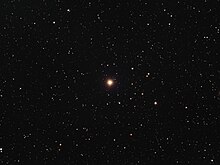피오리개
Pi Aurigae| 관측 데이터 에폭 J2000 이쿼녹스 J2000 | |
|---|---|
| 별자리 | 오리가 |
| 우측 상승 | 05h 59m 56.09830s[1] |
| 탈위임 | +45° 56′ 12.2761″[1] |
| 겉보기 크기 (V) | 4.25[2] |
| 특성. | |
| 진화 단계 | 점근성 거목[3] |
| 스펙트럼형 | M3 II[4] |
| U-B색지수 | +1.83[2] |
| B-V색지수 | +1.72[2] |
| 변수형 | LC[5] |
| 아스트로메트리 | |
| 방사 속도 (Rv) | 0.71±0.76km[6]/s |
| 고유 운동 (μ) | RA: −3.987[1]mas/yr Dec.: −9.775[1]mas/yr |
| 시차 (π) | 4.12 ± 0.4984[1] 마스 |
| 거리 | 약 780리 (약 240pc) |
| 절대치수 (MV) | −2.46[7] |
| 세부 사항 | |
| 반지름 | 127+44 −11[1] R☉ |
| 루미도 | 4,257±564[1] L☉ |
| 표면 중력 (log g) | 0.55±0.10[8] cgs |
| 온도 | 3,388±6[8] K |
| 금속성 [Fe/H] | 0.03±0.04[8] 덱스를 만들다 |
| 기타 지정 | |
| 데이터베이스 참조 | |
| 심바드 | 자료 |
피오리는 오리가의 라틴어로 북쪽 별자리에 있는 붉은 색의 단일 [10]별을 가리키는 바이엘 명칭이다.진도 2의 별 베타오리개에서 북쪽으로 약 1도 떨어진 곳에 위치한 [11]피오리개는 겉보기 시각적 크기 4.25로[2] 육안으로 볼 수 있다. 시차 측정에 따르면 지구에서 약 780광년(240파섹) 떨어져 있다.[1]그 거리에서 항성의 밝기는 성간 가스와 먼지로 인한 소멸로 인해 0.54 정도 감소한다.[6]
Pi Aurgie는 M3 II의 별 분류를 가진 진화된 밝은 거성별이다.[4]중심부의 수소 공급을 소진시킨 후, 그 별은 태양의 약 127배까지[1] 팽창했다.LC 타입의 느린 불규칙 변수로 분류되며 밝기는 크기 +4.24에서 +4.34까지 다양하다.[5]평균적으로, 이 별은 3,388 K의 유효 온도에서 확대된 광권으로부터 태양 광도의 6,493배를[12] 방출하고 있다.[8]
참조
- ^ a b c d e f g h i Brown, A. G. A.; et al. (Gaia collaboration) (August 2018). "Gaia Data Release 2: Summary of the contents and survey properties". Astronomy & Astrophysics. 616. A1. arXiv:1804.09365. Bibcode:2018A&A...616A...1G. doi:10.1051/0004-6361/201833051.이 소스에 대한 가이아 DR2 기록 VizieR.
- ^ a b c d Johnson, H. L.; et al. (1966), "UBVRIJKL photometry of the bright stars", Communications of the Lunar and Planetary Laboratory, 4 (99): 99, Bibcode:1966CoLPL...4...99J.
- ^ Eggen, Olin J. (July 1992), "Asymptotic giant branch stars near the sun", Astronomical Journal, 104 (1): 275–313, Bibcode:1992AJ....104..275E, doi:10.1086/116239.
- ^ a b Morgan, W. W.; Keenan, P. C. (1973), "Spectral Classification", Annual Review of Astronomy and Astrophysics, 11: 29, Bibcode:1973ARA&A..11...29M, doi:10.1146/annurev.aa.11.090173.000333.
- ^ a b Ruban, E. V.; et al. (September 2006), "Spectrophotometric observations of variable stars", Astronomy Letters, 32 (9): 604–607, Bibcode:2006AstL...32..604R, doi:10.1134/S1063773706090052, S2CID 121747360.
- ^ a b Famaey, B.; et al. (January 2005), "Local kinematics of K and M giants from CORAVEL/Hipparcos/Tycho-2 data. Revisiting the concept of superclusters", Astronomy and Astrophysics, 430 (1): 165–186, arXiv:astro-ph/0409579, Bibcode:2005A&A...430..165F, doi:10.1051/0004-6361:20041272, S2CID 17804304.
- ^ Anderson, E.; Francis, Ch. (2012), "XHIP: An extended hipparcos compilation", Astronomy Letters, 38 (5): 331, arXiv:1108.4971, Bibcode:2012AstL...38..331A, doi:10.1134/S1063773712050015, S2CID 119257644.
- ^ a b c d Wu, Yue; et al. (January 2011), "Coudé-feed stellar spectral library - atmospheric parameters", Astronomy and Astrophysics, 525: A71, arXiv:1009.1491, Bibcode:2011A&A...525A..71W, doi:10.1051/0004-6361/201015014, S2CID 53480665.
- ^ "pi. Aur -- Pulsating variable Star", SIMBAD, Centre de données astronomiques de Strasbourg, retrieved 2012-08-20.
- ^ Eggleton, P. P.; Tokovinin, A. A. (September 2008), "A catalogue of multiplicity among bright stellar systems", Monthly Notices of the Royal Astronomical Society, 389 (2): 869–879, arXiv:0806.2878, Bibcode:2008MNRAS.389..869E, doi:10.1111/j.1365-2966.2008.13596.x, S2CID 14878976.
- ^ O'Meara, Stephen James (2007), Steve O'Meara's Herschel 400 Observing Guide, Cambridge University Press, p. 23, ISBN 978-0521858939.
- ^ McDonald, I.; et al. (2012), "Fundamental parameters and infrared excesses of Hipparcos stars", Monthly Notices of the Royal Astronomical Society, 427 (1): 343–357, arXiv:1208.2037, Bibcode:2012MNRAS.427..343M, doi:10.1111/j.1365-2966.2012.21873.x, S2CID 118665352.




